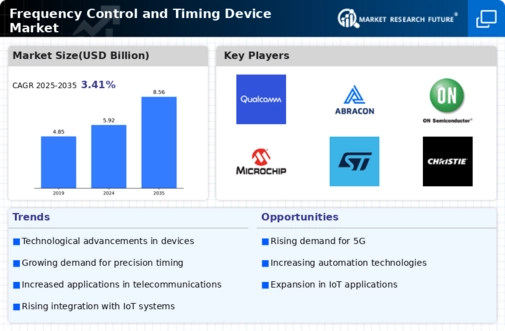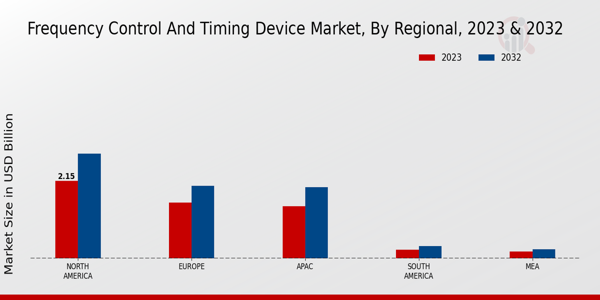Emergence of Smart Grids
The transition towards smart grids is reshaping the energy sector, creating new opportunities for the Frequency Control and Timing Device Market. Smart grids require precise timing and frequency control to optimize energy distribution and enhance grid reliability. As governments and utilities invest in smart grid technologies, the market for frequency control devices is expected to expand significantly. By 2027, investments in smart grid infrastructure are anticipated to surpass 100 billion USD, indicating a robust demand for timing devices that can support the complex requirements of modern energy systems. This trend underscores the critical role of the Frequency Control and Timing Device Market in facilitating energy efficiency and sustainability.
Growth in Automotive Electronics
The automotive sector is undergoing a transformation, with the integration of advanced electronics in vehicles. The Frequency Control and Timing Device Market is poised to benefit from this trend, as modern vehicles increasingly rely on precise timing devices for various applications, including navigation systems, infotainment, and safety features. The automotive electronics market is projected to reach 400 billion USD by 2026, indicating a substantial opportunity for frequency control devices. This growth reflects a shift towards smarter, more connected vehicles, thereby enhancing the relevance of the Frequency Control and Timing Device Market in the automotive landscape.
Rising Demand for Consumer Electronics
The Frequency Control and Timing Device Market is experiencing a notable surge in demand driven by the proliferation of consumer electronics. As devices such as smartphones, tablets, and wearables become ubiquitous, the need for precise timing and frequency control becomes paramount. In 2025, the consumer electronics sector is projected to reach a valuation exceeding 1 trillion USD, with timing devices playing a crucial role in ensuring optimal performance and functionality. This trend indicates a robust growth trajectory for the Frequency Control and Timing Device Market, as manufacturers seek to enhance device reliability and user experience through advanced timing solutions.
Increased Focus on Industrial Automation
The push towards industrial automation is a key driver for the Frequency Control and Timing Device Market. As industries adopt automation technologies to enhance productivity and efficiency, the need for precise timing devices becomes increasingly critical. The industrial automation market is projected to grow to 300 billion USD by 2026, with timing devices playing a vital role in synchronizing operations and ensuring seamless processes. This growth reflects a broader trend towards smart manufacturing, where the Frequency Control and Timing Device Market is likely to see heightened demand for innovative timing solutions that can support automated systems.
Expansion of Telecommunications Infrastructure
The Frequency Control and Timing Device Market is significantly influenced by the ongoing expansion of telecommunications infrastructure. With the advent of 5G technology, there is an increasing requirement for high-precision timing devices to support faster data transmission and improved connectivity. The telecommunications sector is expected to invest over 300 billion USD in infrastructure development by 2026, which will likely drive demand for frequency control devices. This expansion not only enhances communication capabilities but also propels the Frequency Control and Timing Device Market forward, as companies strive to meet the stringent requirements of next-generation networks.






















Leave a Comment